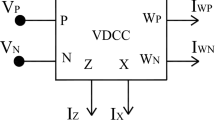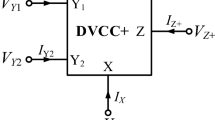Abstract
Design of integrated circuits is possible both in voltage and current- mode type of analog signal processing. Designing analog integrated circuits is a state of the art that has received incredible advancement from the viewpoint of development of VLSI technology. The application of current-mode designs now dominates conventional voltage-mode designs. Numerous circuits and techniques are presented in the literature for designing wide variety of voltage and current-mode processing circuits which can be suitably implemented in CMOS and Bi-CMOS technology. Current-mode signal processing being a striking approach because of the ease of performing mathematical operations like addition, subtraction, multiplication and the circuits can be operated at high bandwidth than their voltage-mode counterparts. This paper presents the design of a current-mode continuous-time high-frequency biquadratic filter suitable for implementation in VLSI technology.
Access provided by Autonomous University of Puebla. Download conference paper PDF
Similar content being viewed by others
Keywords
- Continuous-time filters
- Biquadratic filters
- Complementary current-mirrors
- Kerwin–Huelsmann–Newcomb (KHN) biquad
- Current-mode signal processing
1 Introduction
Current-mode technique has been received commendable attention, as they offer following advantages: (i) high slew-rate, (ii) low-power consumption, (iii) operating frequency range is superior, (iv) enhanced accuracy and linearity. Interest in design of current-mode (CM) [1, 2] filters has developed, but for operation at higher frequencies (in MHz range) [3, 4], the main challenges faced during the design of analog filters are (i) consistent high-frequency performance, (ii) automatic on-chip availability of tuning and (iii) varying operating conditions.
Thus, for high-frequency applications, the output must be current, and it should be given as
where gm is the transconductance of the active analog building block. For application as continuous-time filters, the transconductance (gm) of the circuit should meet the following properties: linear, simpler and have wide frequency response, should have high output and input impedance to simplify circuit design, operate at low-voltage preserve power and to make it compatible with the digital technology. The gm depends on DC bias voltage (VB) or current (IB) to make circuits electronically tunable against the environmental variation.
Depending on the choice of the technology, the operating frequency range of the gm circuits [3] can be extended to be greater than 50 MHz (for CMOS technology), greater than 500 MHz (for bipolar technology) or even greater than 1 GHz (for GaAs technology) for designing high-frequency continuous-time telecommunication circuits.
As capacitors and the transconductors are the only components required for realizing filters, gm-C [5, 6] filters can readily be implemented in fully integrated form [7], with desired technology. For active simulations, we consider identical transconductors and grounded capacitors for simple layout and processing. In addition to this, the large bandwidth of transconductance and reduced parasitic effects of device and circuit on filter performance results in higher working frequency range of the circuits.
2 Biquadratic Filter
An electric filter is a two-port network which shapes the frequency band of the input in order to obtain an output with the preferred frequency. Thus, it has pass band and stop band, respectively, in which the frequencies are transmitted and rejected at the output.
2.1 Current-Mode KHN-Equivalent BiQUAD
It can be implemented by cascading two lossless integrators [8,9,10] to obtain five filter functions namely: low-pass, high-pass, band-pass, band-elimination and all-pass responses.
Figure 1 shows the block schematic representation of current-mode KHN-equivalent biquad , and the routine analysis has been carried out to find the current transfer functions. Figure 2 shows the CMOS realization of the proposed CM KHN-equivalent biquad using complementary current-mirror pair [11].
2.2 Mathematical Analysis
From Fig. 1, we obtain the following three equations:
From Eqs. (3) and (4), we have
Now, substituting the value of Io1 and Io2 from Eqs. (4) and (5) in Eq. (1), we obtain an expression for the current Io3 in terms of input current Iin as
Thus, Eq. (6) represents a high-pass response.
Similarly, when the value of Io3 is substituted from Eq. (6) in Eqs. (4) and (5), respectively, we obtain the expression for the currents Io1 and Io2 in terms of input current Iin as follows:
Thus, Eqs. (7) and (8), respectively, represent a band-pass response and a low-pass response.
Similarly, the currents Io4 can be written as
Now, substituting the value of the currents Io3 and Io1 from Eqs. (6) and (8), respectively, in Eq. (9), we obtain an expression for the current transfer function Io4/Iin.
Thus, Eq. (10) represents a notch response.
Similarly, for the current Io5, we have the following expression:
Now, substituting the value of the currents Io4 and Io2 from Eqs. (10) and (7), respectively, in Eq. (11), we obtain the expression for Io5/Iin.
Thus, Eq. (12) represents an all-pass response.
The expressions for the filter parameters namely the cut-off frequency (ωo) and the quality factor (Q) can be obtained from the above current transfer function, and they are given by:
where
where gm1 and gm2 are the transconductance of the diode-connected transistors Q12 and Q17, respectively. Also, IB1 and IB2 are the DC bias currents shown as IB2 and IB4 in Fig. 2.
But the transconductances gm1 and gm2 are directly related to the square root of the bias currents IB2 and IB4 and are given as
Therefore, the expression for filter parameters ωo and Q becomes
If C1 = C2 = C, then Eqs. (17) and (18) become
Also, if IB2 = IB4 = IB, then Eqs. (19) and (20) become
3 Simulation Results
The proposed circuit of Fig. 2 was verified using SPICE with 0.5 µm CMOS process parameters provided by MOSIS (AGILENT). These parameters are listed in Table 1 [12,13,14,15,16].
For the circuit shown in Fig. 2, the analysis was carried out with DC bias current IB1 = IB3 = IB5 = 24 µA, IB2 = IB4 = 15 µA, C1 = 0.01 pF, C2 = 0.1 pF, (W/L)P ratio = 1 µm/1 µm, (W/L)N ratio = 1 µm/1 µm and supply voltage VDD = 1.5 V.
The simulated value of the cut-off frequencies for low-pass, high-pass and band-pass response is found to be: (f0)LPF = 51.67 MHz, (f0)HPF = 95.404 MHz and (f0)BPF = 88.444 MHz, respectively. The band-pass filter has a bandwidth of 186.894 MHz.
The simulated results are very well in agreement with the theoretical results that were found to be: (f0)LPF = 52 MHz, (f0)HPF = 95 MHz, (f0)BPF = 88 MHz and BW = 185 MHz, respectively. The SPICE simulation for the proposed circuit has been shown in Fig. 3.
Figures 4 and 5, respectively, represent the variation in the cut-off frequency and gain of the band-pass and the low-pass responses of the current-mode KHN-equivalent biquad circuit shown in Fig. 2.
4 Conclusions
This paper presents high-frequency CM KHN-equivalent biquad filter suitable for operation at high frequencies they can operate at a low voltage of 1.0 V [17,18,19,20,21,22,23,24]. It can also be concluded that by varying the capacitor or the bias current, improves the gain and the operating frequency of the filter. Therefore, frequency of the filter can be controlled through a single DC bias current, thus providing good electronic tunability. The circuit was verified using SPICE, and simulation results confirm theoretical results.
References
J.C. Ahn, N. Fujii, Current-mode continuous-time filters using complementary current mirror pairs. IEICE Trans. Fundam. E79-A(2), 168–175 (1996)
R. Angulo, M. Robinson, E.S. Sinencio, Current-mode continuous-time filters: two design approaches. IEEE Trans. Circuits Syst. 39(5), 337–341 (1992)
R. Schaumann, M.S. Ghausi, K.R. Laker, Design of Analog Filters: Passive, Active RC, and Switched Capacitor (Prentice Hall, Englewood Cliffs, NJ, 1989)
C. Toumazou, F.J. Lidgey, D.J. Haigh, Analogue IC Design: The Current-Mode Approach (Peter Peregrinus Ltd, 1990)
A. Bhandari, A.A. Husain, M.S. Chadha, A. Gupta, Lossy and lossless current-mode integrators using CMOS current mirrors. Int. J. Eng. Res. Dev. 9(3), 34–41 (2013)
A.A. Husain, M.S. Chadha, A. Gupta, A. Bhandari, Design of high frequency current-mode continuous-time filter using CMOS current-mirrors. IOSR J. VLSI Signal Process. 3(6), 58–62 (2013)
S.S. Lee, R.H. Zele, D.J. Allstot, G. Liang, CMOS continuous-time current-mode filters for high-frequency applications. IEEE J. Solid-State Circuits 28(3), 323–329 (1993)
R. Senani, V.K. Singh, KHN-equivalent biquad using current conveyors. Electron. Lett. 31(8), 626–628 (1995)
A.M. Soliman, Kerwin-Huelsman-Newcomb circuit using current conveyors. Electron. Lett. 30(24), 2019–2020 (1994)
A. Toker, S. Ozouguz, C. Acar, Current-mode KHN-equivalent biquad using CDBAs. Electron. Lett. 35(20), 1682–1683 (1999)
M.S. Chadha, A. Gupta, A. Bhandari, A.A. Husain, Third-order current-mode filter realization using CMOS current-mirror. IOSR J. Eng. 3(12), 32–39 (2013)
R.W.J. Barker, Accuracy of current mirrors, in IEE Colloquium on Current Mode Analogue Circuits, London, vol. 25, paper 2 (1989)
B.L. Hart, R.W.J. Barker, Negative current-mirror using n-p-n transistors. Electron. Lett. 13, 311–312 (1977)
B.L. Hart, R.W.J. Barker, Modified current mirror with a voltage-following capability. Electron. Lett. 18, 970–972 (1982)
F.J. Lidgey, Looking into current mirrors. Wireless World 85, 57–59 (1984)
R. Senani, A.K. Singh, A new universal current-mode biquad filter. Frequenz J. Telecommun. (Germany) 56(1/2), 55–59 (2002)
A.M. Soliman, Mixed-mode biquad circuits. Microelectron. J. 27(6), 591–594 (1996)
C. Toumazou, F.J. Lidgey, P.Y.K. Cheung, Current-mode analogue signal processing circuits—a review of recent developments, in IEEE International Symposium on Circuits and Systems, Portland, USA, vol. 3 (1989), pp. 1572–1575
Y.P. Tsividis, Integrated continuous-time filter design—an overview. IEEE J. Solid-State Circuits 29(3), 166–176 (1994)
T. Tsukutani, M. Ishida, S. Tsuiki, Y. Fukui, Current-mode biquad without external passive elements. Electron. Lett. 32(3), 197–198 (1996)
T. Voo, C. Toumazou, High-speed current mirror resistive compensation technique. Electron. Lett. 31(4), 248–249 (1995)
G. Wegmann, E.A. Vittoz, Very accurate dynamic current mirrors. Electron. Lett. 25, 644–646 (1989)
B. Wilson, F.J. Lidgey, C. Toumazou, Current mode signal processing circuits, in IEEE Symposium on Circuits and Systems, Helsinki, vol. 3 (1988), pp. 2665–2668
A. Gupta, M.S. Chadha, A. Bhandari, A.A. Husain, A novel approach for realization of higher order filter using bipolar and MOS current-mirrors. IOSR J. Electron. Commun. Eng. (IOSR-JECE) 9(1), 99–104 (2014)
Acknowledgements
This work was performed at Electronics CAD Lab of ECE Department, I.T.S. Engineering College, Greater Noida, India.
Author information
Authors and Affiliations
Corresponding author
Editor information
Editors and Affiliations
Rights and permissions
Copyright information
© 2020 Springer Nature Singapore Pte Ltd.
About this paper
Cite this paper
Gupta, A. (2020). Continuous-Time High-Frequency Current-Mode Kerwin–Huelsmann–Newcomb (KHN)-Equivalent Biquad Filter Using MOS Complementary Current-Mirror. In: Saini, H.S., Singh, R.K., Tariq Beg, M., Sahambi, J.S. (eds) Innovations in Electronics and Communication Engineering. Lecture Notes in Networks and Systems, vol 107. Springer, Singapore. https://doi.org/10.1007/978-981-15-3172-9_37
Download citation
DOI: https://doi.org/10.1007/978-981-15-3172-9_37
Published:
Publisher Name: Springer, Singapore
Print ISBN: 978-981-15-3171-2
Online ISBN: 978-981-15-3172-9
eBook Packages: EngineeringEngineering (R0)









